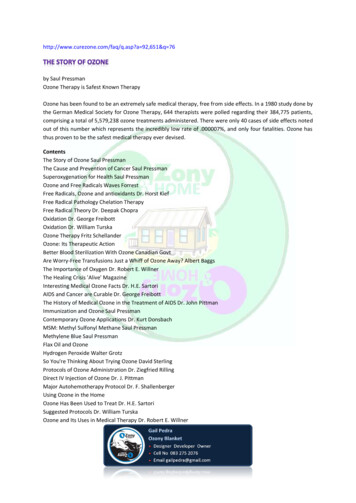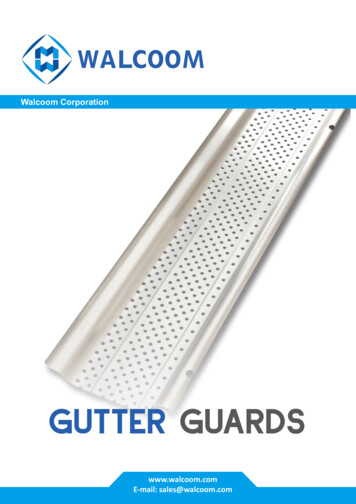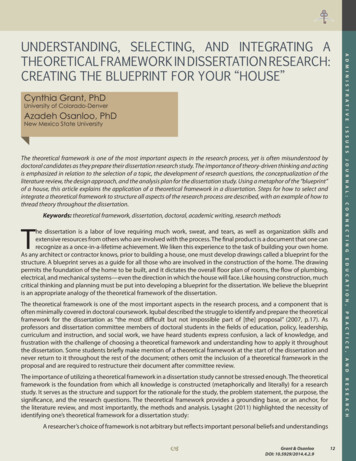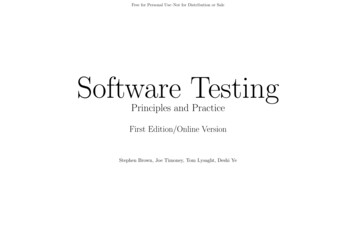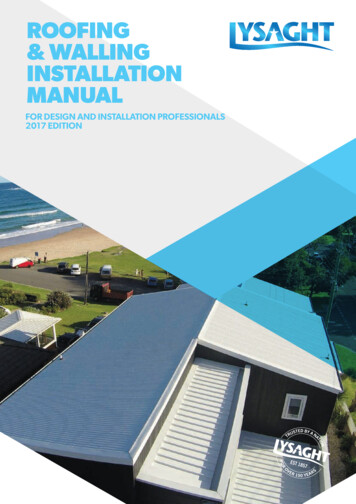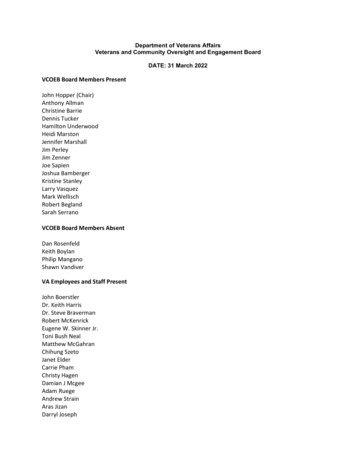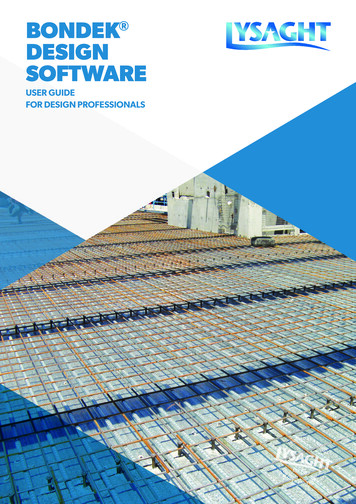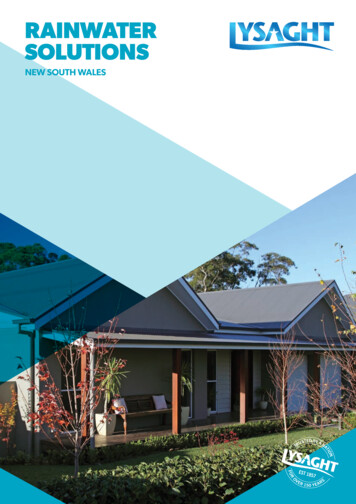
Transcription
RAINWATERSOLUTIONSNEW SOUTH WALES
RAINWATER SOLUTIONSWater overflow in domestic rainwater systemsUnder the Environmental Planning and Assessment Act 1979 and its Regulations, all building work must becarried out in accordance with the ABCB National Construction Code 2016 (NCC). In addition to referringto Australian Standards AS/NZS 3500.3:2015 Plumbing and Drainage – Stormwater Drainage, the NCC alsocontains requirements for the disposal of surface water in Volume One, in Performance Requirements FP1.2and FP1.3, and in Volume Two, in Part 3.5.2, namely, Performance Requirements P2.2.1 and Clauses 3.5.2.1and 3.5.2.4.The most common means to satisfy these requirements for roofdrainage (i.e. guttering) installations is via compliance with theAS/NZS 3500.3.B) Methods related to alternative building designs methods:Furthermore, in each state and territory it is necessary to satisfythe relevant regulation. For example, the NSW Code of Practicefor Plumbing and Drainage (2006) adopts AS/NZS 3500.3 andassociated amendments. G utter installed such that the gutter front is fully and sufficientlybelow the top of the fascia (freeboarding).In the design and detailing of a roof drainage system considerationmust be given to a range of the factors such as rainfall intensity,roof catchment area, gutter size/capacity, gutter fall, gutteroutlets (sumps, rainheads, nozzles), downpipe size, quantity andplacement, overflow consideration, material selection, jointing, etc.It is the responsibility of designers and installers of roof drainagesystems to ensure compliance with these requirements.IMPORTANT INFORMATION ON OVERFLOW MEASURESFor residential roof drainage systems, high fronted gutters are apopular aesthetic choice to hide the lower edge of tiles or roofcladding. Where high-fronted gutters are installed, the NCC (andAS/NZS 3500.3) requires that provision must be made to avoidany overflow back into the roof or building structure.Some simple overflow control methods that can be employed onhigh fronted gutters are listed below. It is important to note thatit may be necessary to use more than one of these measures toachieve the necessary result: U nlined eaves – eliminates the issue where the house designsuits. D esign for a higher rainfall intensity, as used for internal boxgutters. B ack flashing – where gutter support brackets allow backflashing installation (e.g. external brackets).The following illustrations show some typical continuous and noncontinuous overflow measures that may be used in combinationwith each other or with other overflow measures to meet thenecessary requirements.Please note that non-continuous measures may become blockedanywhere along their length, so non-continuous overflow measuresmay not be sufficient to prevent water from flowing back into abuilding.Slotted gutters may also provide an overflow measure, howeverslots must be of sufficient size. For this reason, slots alone maynot be a sufficient overflow measure in all circumstances. Whendesigning a roof drainage system with slotted gutter, considerationshould be given to additional overflow measures.A) Methods related to the design and installation of roof drainagesystems: S lotted front of gutter – simple and popular choice which allowsfor water overflow through the slots visible on the front face ofthe gutter; Specifically located non-continuous overflows as permitted inthe NCC i.e.:-- I nverted downpipe drop/pop at high points in the gutter butset at a level below the fascia top,-- Stop ends cut down to a lower level to act as a weir (stopend weirs could be hidden at the high point of the gutter anddesigned as part of an expansion joint),-- Rainheads with overflow weir,RAINWATER SOLUTIONS-- Holes, slot, or weir at downpipes; Gap between the fascia and the gutter back – a packer isinserted between the gutter back and the fascia; or Any of a number of other proprietary systems and tradesolutions.Typical overflow from slotted gutter.(Gutter shown is not available in all areas).2
DESIGN AND INSTALLATION OF DOMESTIC ROOFDRAINAGE SYSTEMSContinuous (full length) overflow measuresThe detailing and sizing of the selected overflow method/sis normally completed by the designer/installer, but must beadequate for the situation and must meet the relevant performancerequirements of the NCC and Australian Standards, including therequirements noted above.While there may be some variations from state to state, contractorswho install guttering systems are generally required to hold anappropriate licence. In NSW, for example, a licence in the categoryof Builder, Plumber or Roof Plumber issued by the Office of FairTrading is required and it is an offence to undertake this workwithout an appropriate licence. The work is required to complywith the appropriate codes and standards.GutterFront of gutter below top of fasciaFasciaStatutory warranties normally apply and consumers have a rightto lodge a complaint and have it dealt with by the appropriateauthority. In NSW, for example, the statutory warranty is up to6 years under the Home Building Act.GutterGap between gutter and fasciaIn the installation of the roof drainage system, particular focusshould be given to the following; Attention to the use of compatible materials for drainagesystem components, leaf-guard type system componentsand compatible fasteners/sealants to connect and seal thecomponents.Non-continuous (specifically located) overflow measures The position of the gutter in relation to the fascia (particularly,whether there is a gap between the fascia and the gutter backand whether the gutter front is below the top of the fascia).Downpipe nozzle I nstallation of the specified gutter and downpipes, ensuring thatdownpipes are installed in the correct locations and numbers.Gutter Gutter fall, ensuring sufficient fall and that it is in the direction ofthe downpipes. O verflow has been considered and specific details are installedwhere required as described above (such as when the gutterfront is higher than the top of the fascia).During the installation all debris and loose waste materials (swarf,fasteners, etc.) must be cleaned off at the end of each day andat the completion of the installation to prevent blockages of thedrainage system or deterioration of the individual components. Anyprotective films should also be removed as part of the installationprocess.MAINTENANCE OF DOMESTIC ROOF DRAINAGESYSTEMSInverted nozzle at high ends of gutterfinished below back of gutterFasciaGutterStop ends finished below the top of thefascia and rear of the gutter to form a weir3To ensure the long life of the roof drainage system, themaintenance requirements of the roof drainage system should beforwarded to the occupier/owner of the building and should befulfilled. Adequate maintenance is a requirement of rainwater goodswarranties.RAINWATER SOLUTIONSIn the longer term, the ability of a roof drainage system to handleoverflow will also depend on the regular cleaning of the system.For example the removal of plant or animal matter (leaves, fungalgrowth, dropping, nests, etc.) and debris from gutters, leaf-guardtype systems and the gutter overflow devices to ensure freedrainage of water.
Information on designing a perimeter drainage systemfor a domestic roofRoof drainage systems can be affected by a number of variablesand must be designed and detailed by a suitably qualified trade orprofessional. The design of roof drainage aims to protect people,property and the building. The designed drainage system must beinstalled under the supervision of a qualified trade or professional.The steps of the design process are illustrated below.1. D ecide on the average recurrence interval (ARI). Wheresignificant inconvenience or injury to people, or damage toproperty (including contents of a building), is unlikely (typicalof an eaves-gutter system) a minimum ARI can be 20 years. Ifthese conditions are likely (typical of box gutters) 100 years isrecommended.1. Determine average recurrence interval (ARI).2. Determine rainfall intensity for the site from Table 1. More dataare in AS/NZS 3500.3.2. Obtain rainfall intensity of site.3. Sketch a roof plan showing dimensions in plan view, pitch ofroof, layout of ridges and valleys and large roof penetrations.3. Work out roof dimensions.4. Determined catchment area with slope.5. Determine area for proposed eaves gutter.6. Determine catchment area per downpipe.7. Determine number of downpipes required.8. Determine location of downpipes and high points.9. Check catchment area for each downpipe.10. Determine downpipe size.5. G et the effective cross-sectional area of the gutter you intend touse from Table 2.6. U sing the cross-sectional area of the gutter on the graph inFigure 1, determine the catchment area per downpipe.7. Calculate (as a first test) the minimum number of downpipesrequired for the selected gutter using the equation:11. Determine overflow measures.Table 1Design rainfall intensities adapted from NCC, Volume 2, Table3.5.2.1.ARI once in 20 yearsmm/hrARI once in 100 yearsmm/hrACTCanberra4. Calculate the catchment area of the roof from the plan. To allowfor the slope of the roof, increase the plan area. Refer toAS/NZS 3500.3 for the increased area. As a ‘rule of thumb’allow 1% for every degree of pitch up to 36 .143193Gungahlin137179Tuggeranong148210New South WalesAlbury139180Broken Orange142186Number ofdownpipes (min.) Total catchment area of the roofCatchment area (determined in 6)Round the number of downpipes up to the next whole number.8. On the plan, select locations for the downpipes and the highpoints in the gutters. Where practical, the catchments for eachdownpipe should be about equal in area.When selecting the location of high points and downpipes,consideration should also be given to proximity to highconcentrations of water flow (e.g. valley gutters, diversionsaround large roof penetrations, dormers, etc.). More guidanceis given in AS/NZS 3500.3, HB114:1998 and NCC.Calculate the area of each catchment for each downpipe.9. With the area of your eaves gutter, check that the catchmentarea for each downpipe, calculated in Step 8, is equal to or lessthan the catchment area shown by the graph.If a catchment area is too big then you can:200262 Increase the number of downpipes;Avalon206278 Reposition the downpipes and/or the high points;Campbelltown167222Penrith180244 Choose a gutter with bigger effective cross-sectional area,then repeat the above from Step 6.Sydney175233Tweed HeadsWindsor252330Wollongong217308DESIGN PROCEDURERAINWATER SOLUTIONSThe steps in the design process are for a perimeter drainage systemusing the standard roll-formed rainwater products (gutters) installedat the building eaves. Drainage systems for larger roofs use boxgutters at the perimeter and internally. Box gutter systems arethoroughly treated in AS/NZS 3500.3 and HB114:1998.Diagrams, charts and data extracted from other publications (suchas NCC, AS/NZS 3500.3, etc.) are indicative only. Referenceshould be made to these other publications for the most recentinformation.4Install gutters with a suitable fall to avoid ponding and to allowwater to easily flow away. Steeper falls are preferred for prolongedlife of the gutter. Refer to the NCC and the Australian Standards forguidance. Eaves gutters must have a gradient of 1:500 or steeper.10. Decide on the downpipe size. Recommendations inAS/NZS 3500.3 on downpipe sizes. Table 2 gives the standardsize downpipes available to suit the requirements given inAS/NZS 3500.3.11. C onsider measures to counter potential overflow of gutters intothe building (see pages 2 and 3). Consideration of overflowat high concentrations of water flow may need to be given.Guidance on this matter is given in NSW Dept of Fair Tradingbulletin FTB40 (January 2009).Overflow capacity of slots in the LYSAGHT gutters are provided inTable 3.
Figure 1LYSAGHT gutter areas and downpipes. Minimum standard downpipe sizes to suitgutters (gutter gradient 1:500)Effective #cross sectionRound(diameter)Rectangularor ad Lo-frontno616590100x50SHEERLINE 0100100x75yes467590100x50no7042100100x75150 Half RoundFlat Backyes460290100x50no6914100100x75Half Round 100no430075100x50*Half Round 125no630090100x50*Half Round 150no9200§100x75*Half Round 200no14500§§Half Round 250no24500§§Half Round 300no35300§§HIP OR GABLE ROOFRidgeRidgeRoof pitchRoof pitchEavesEavesH Roof widthH Roof widthTable 3LYSAGHT gutter slot overflow 5050200403003040020500Design rainfallintensities (mm/h)1003000 4000 5000 600010000 11000 120007000 8000 9000Effective cross-sectional area of eaves gutter (mm2)(Gradient 1:500 and steeper).# Values calculated in accordance with AS/NZS 3500.3.§ Non standard downpipe and nozzle/pop is required.* Non standard nozzle/pop is required to suit rectangular downpipe.SINGLE SLOPE ROOF5080EXAMPLEFind the minimum catchment areafor each downpipe on a house inTuggeranong using Quad Hi-frontgutter.MethodUsing the gutter cross sectionalarea taken from Table 2 (shownacross the bottom of the graph)draw a line upwards until itintersects with the Design rainfallintensity (Table 1). Draw a line at90º to determine the catchmentarea for each sign rainfallintensities (mm/h)1003000 4000 5000 60007000 8000 900010000 11000 12000Effective cross-sectional area of eaves gutter (mm2)(Gradient 1:500 and steeper).DATADesign rainfall intensity 148 (Table 1)Gutter area 5804 (Table 2)FlexiblefixCatchmentareaDomestic22.5 pitchedroof width “H”CatchmentareaDomestic22.5 pitchedroof width “H”m2 perm runof guttermm2 perm runof 002.11.73.63.0Notes:1. Check with your local service centre for the availability of slots.2. Slot overflow is based on test results.3. The slot capacity is conservative and can be used for all gutters produced in NSW.4. Flexible-fix refers to long straight runs of gutters. Rigid-fix refers to short length of guttersthat are rigidly held in place by corners, downpipes, and the like.5. The rainfall intensity is for an ARI of 1:100 years6. No allowance has been given to drainage from upper roof or wall surfaces. Noallowance has been given to roof penetrations or high concentrations of water flowSOLUTION (From Figure 1)Catchment area for each downpipe 37m2RAINWATER SOLUTIONS150 Half Round905TRIMLINE 100Catchment area for each vertical downpipe (m2)Quad Hi-frontSlottedCross-sectional area of eaves gutters required for various roofcatchment areas (where gradient of gutter is 1:500 and steeper).(Adapted from AS/NZS 3500.3).Catchment area for each vertical downpipe (m2)Table 2
LYSAGHT GUTTERS, FASCIA AND ACCESSORIESZingerQUADHi-Front90mm62mm115mmProfile shown unslotted for 73mmTRIMLINE 124mmProfile shown unslotted for clarity.141mm81mmSHEERLINE 124mmProfile shown unslotted for clarity.150 HALF ROUND& FLAT BACK150mm73mm136mm97mmProfile shown slotted.HALF ROUND(Bought in)74mmProfile shown slotted.BRAINWATER SOLUTIONS18mmNOVALINE Fascia97mm185mm35mm6
LYSAGHT quality gutters and fascia are available in unpainted ZINCALUME steel and in a range of COLORBOND steel pre-paintedcolours to match or contrast your roof. All accessories shown below are manufactured with compatible materials. Visible accessories areavailable plain or coloured to match the gutter and fascia. Classic design that is the leading choice in new homes The high front design obscures the roofline for a moreattractive finishACCESSORIES Compatible with NOVALINE Fascia System for quick,easy attachment to the building Available with optional slotting to allow overflow inconjunction with additional overflow measures, Plain &coloured* Suitable for steel or tile roofsStop end Internal corners(pair)90 and 45 Plain &Plain & coloured*coloured* 2 piece castalso availableExternal corners Overstrap90 and 45 Plain*Plain & coloured*2 piece castalso availableConcealed Internalbracketstop endPlain*plates (pair)Plain &coloured*2 piece cast90 InternalCornerPlain &coloured2 piece cast90 ExternalCornerPlain &colouredACCESSORIES Traditional design that is suitable for new homesor to match existing gutters Popular as a replacement gutter Compatible with NOVALINE Fascia System forquick, easy attachment to the building Suitable for steel or tile roofs Slim, elegant square gutter particularly suited todomestic applications that is fast and simple to installInternal bracketPlainExternal bracketPlain & colouredStop endplates (pair)Plain &colouredOverstrapPlainInternal corner External corner90 and 45 90 and 45 Plain & coloured Plain & colouredACCESSORIES Concealed fixing offers clean, attractive ‘trim’ lines Compatible with NOVALINE Fascia System for quick,easy attachment to the building Available with optional slotting to allow overflowin conjunction with additional overflow measures,where necessaryGeneral purposebracketPlain & colouredExternalend stop (pair)Plain & colouredOverstrapPlain Suitable for steel or tile roofs Popular for home improvement projects like patios,pergolas and sheds and for use with high profileroofing laid at low pitches or traditional domestic roofsrequiring large water carrying capacityACCESSORIES124mm30mm141mm Concealed fixing offers clean and seamless finish SHEERLINE capping available for trimming roof edges Available with optional slotting to allow overflow inconjunction with additional overflow measures, wherenecessary Large water carrying capacity for high rainfall areasand large roof sizesGeneralpurposebracketPlainUniversalgutter clip(SGCI)PlainExternalend stop(pair)Plain &colouredInternalend stop(pair)Plain &colouredZed bracket InternalHot dipped CornerGalvanised 90 Plain &colouredInternalCorner135 Plain &colouredExternalCorner90 Plain &colouredExternalCorner135 Plain &colouredCappingPlain &colouredACCESSORIES Curved base provides improved self-cleaning andminimises build-up of water and dirt A complete range of accessories are available Flat Back gutter offers concealed fixing for clean andseamless finish Available with optional slotting to allow overflowHalf roundexternalbracketsPlain &coloured*Flat back concealedsuspension bracket(Flat back generalpurpose bracket)PlainFlat backoverstrapsPlain*Cast externalcorners90 and 45 Plain & coloured*Cast internalcorners90 and 45 Plain & coloured*End stop (pair)Plain & coloured*ACCESSORIES L arge water carrying capacity for high rainfall areasand large roof sizes D imensions (Nominal diameter) B 100mm,125mm, 150mm, 200mm, 250mm, 300mmA4 bracketPlain & colouredFasciaA1 bracketPlain & colouredEnd stop (pair)Plain & colouredACCESSORIES Perfect with Quad and TRIMLINE gutters N OVALINE Fascia replaces traditional timberfascia which reduces painting and maintenance N OVALINE Fascia Cover can be used as a quickfix over existing timber fasciaBarge mouldleft and rightPlain &coloured*Apex cover Multipurpose Hip rafter NOVALINE Plain &bracketbracket spacer insertcoloured* Plain*Plain*7 Extensive range of accessoriesSpring clip InternalInternal and external InternalPlain*splice plate corner 90 and 45 cover cap 90 PlainPlain & coloured*Plain &coloured*RAINWATER SOLUTIONS Heavy duty brackets available*Product is available in COLORBOND Ultra steel or Heavy Coated, designed for severe coastal and industrial environments.
DOWNPIPES & ACCESSORIESCompleting your rainwater systemFinish your roof with the distinctive style of the LYSAGHT downpipes and accessories. These downpipes andaccessories are compatible with the NOVALINE Fascia System, and with a wide range of gutters.All LYSAGHT downpipes and accessories are made fromgalvanised or ZINCALUME steel, which means they are strong andmade to last.match or contrast with your roof. They are compatible with steeland tile roofs.Most downpipes and accessories are available in unpaintedZINCALUME steel and a range of COLORBOND steel colours toA wide range of rectangular, square and round downpipesavailable to complement all building styles. Some dimensions andavailability may vary slightly from region to region.DOWNPIPESDOWNPIPE ACCESSORIESAstragal/bracketsRectangularor WATER SOLUTIONSAdjustableRound cornerOffsetsSquare corner360-600mmAdjustable300mmAdjustable8
TRADEWORK & FLASHINGSMade to order to your specificationsR efer to the NSW price list for the full range of tradework andflashing products available. Ask your technical sales representativefor details.To order your rainwater head or other trade item, supply detaileddrawings or template showing front and side elevations withdimensions and we can manufacture for you. Some standardTRADEWORKLYSAGHT standardrainwater heads 390 W x 300 H x 250 DCustom made squarerainwater heads(downpipe outlet not included)To your dimensioned drawing.shapes and dimensions are available. For the rainwater heads, theoutlet holes and nozzles are not included.The selection, design, sizing and overflow method should bespecified by a suitably qualified trade or professional in accordancewith NCC and Australian standards.FLASHINGSRidge cappingBarge rollValley flashingRoll top ridge cappingApron flashingBarge gutterBarge cappingTaperedcustom flashingBox guttercustom flashingTapered rainwater heads(downpipe outlet not included)Small: 380 x 175 x 200 mmLarge: 450 x 250 x 250 mmOr to your dimensioned drawing.Custom made roundrainwater headsTo your dimensioned drawing.MATERIALS FOR FLASHINGSCOLORBOND steelCOLORBOND Ultra steelCOLORBOND Metallic steelZINCALUME steelCorner OGEE rainwater headTo your dimensioned drawing. OGEE rainwater headSmall: 310 x 200 mmLarge: 400 x 250 mmOr to your dimensioned drawing. Galvanised steelOTHER PRODUCTSOther rainwater system products are available. Refer to the NSWprice book for full details.OverflowsTo your dimensioned drawing.SpreadersTo your dimensioned drawing.NOVALINE fascia coverMATERIALS FOR TRADEWORKCOLORBOND steelGALVABOND steelCOLORBOND Ultra steelStainless steel 304-2B, 316-2BCOLORBOND Metallic steelCopper ZINCALUME steelSpacerInsertSHEERLINE cappingRAINWATER SOLUTIONSSump. trayTo your dimensioned drawing.9Chinaman’s hatStandard or made to order to yourdimensioned drawing.Sizes from 150-400mm.
INSTALLATION ADVICEGet it right first time with LYSAGHT productsBRACKET SPACINGADVERSE CONDITIONSWhen the gutters are attached to NOVALINE fascia, thenthe gutter bracket spacing should mirror the spacing of theNOVALINE brackets (i.e. 600mm & 1200mm), and the gutterbrackets should be adjacent to the NOVALINE brackets.If these products are to be used within 1km of marine, severeindustrial, or unusually corrosive environments, ask for advice fromour information line.However, when the gutters are fixed to other fascias then theweight of the water carried by the gutter should determine spacingrequired - however spacing should not exceed 1200mm maximum.The roof drainage system should be installed using good tradepractices and by a certified installer. FALLInstall gutters with a suitable fall to avoid ponding and to allowwater to easily flow away. Steeper falls are preferred for prolongedlife of the gutter. Refer to the NCC and the Australian Standards forguidance.METAL & TIMBER COMPATIBILITYRAINWATER SOLUTIONSLead, copper, bare steel and green or some chemically-treatedtimber are not compatible with this product; thus don’t allowany contact of the product with those materials, nor discharge ofrainwater from them onto the product. If there are doubts about thecompatibility of other products being used, ask for advice from ourinformation line.ROOF DRAINAGE SYSTEM DESIGNRoof drainage systems should be designed and detailed by asuitably qualified trade or professional in accordance with theNCC and the Australian Standards. Particular reference should bemade to the correct sizing of gutter; quantity and placement ofdownpipes; and the provision of appropriate overflow devices.(Page 2-3).INSTALLATION ADVICEFor sealed joints use screws or rivets and neutral-cure siliconesealant branded as suitable for use with galvanised orCOLORBOND /ZINCALUME steel.CLEAN UPRemove all plastic cover strips from product and dispose ofcorrectly.Sweep all metallic swarf and other debris from roof areas,gutters, downpipes, overflow devices and all other roof drainagecomponents, at the end of each day and at the completion of theinstallation.GUTTER MAINTENANCEThe roof drainage system (gutter, downpipes, overflow devices andall other components) must be cleaned out on a regular basis.10
GUTTER MAINTENANCEGetting the most from LYSAGHT products1) A typical suburban gutter clogged withleaf litter prior to cleaning.2) Wear correct protection when clearingleaves and twigs.3) When litter is removed, the layer ofhardened dirt is revealed below.4) Rinse the gutter with water to softenand break up the dirt.5) Use a soft bristle brush and sweepthe dirt out. Rinse again.6) When the gutter has been cleaned,it should look like this.CLEANING GUTTERSTwigs, dust, leaves and fungal matter (debris) should be removedregularly from gutters - as failure to do so voids your warranty. S weep debris into a pile using a stiff, soft bristled brush (shovelsor hard tools should not be used).11A well maintained gutter/downpipe will make your rainwatersystem provide years and years of trouble-free service.RAINWATER SOLUTIONS The whole roof and gutter should then be washed down witha hose, including high ends of gutters (possibly protected byoverhangs), rain heads, water spouts and overflow locations.
PRODUCT DESCRIPTIONS All descriptions, specifications, illustrations, drawings,data, dimensions and weights contained in this catalogue,all technical literature and websites containing informationfrom Lysaght are approximations only. They are intendedby Lysaght to be a general description for informationand identification purposes and do not create a sale bydescription. Lysaght reserves the right at any time to:(a) supply Goods with such minor modifications fromits drawings and specifications as it sees fit; and(b) alter specifications shown in its promotionalliterature to reflect changes made after the dateof such publication.DISCLAIMER, WARRANTIESAND LIMITATION OF LIABILITY This publication is intended to be an aid for all tradesand professionals involved with specifying andinstalling Lysaght products and not to be a substitute forprofessional judgement. Terms and conditions of sale available at local Lysaghtsales offices. Except to the extent to which liability may not lawfullybe excluded or limited, BlueScope Steel Limited willnot be under or incur any liability to you for any direct orindirect loss or damage (including, without limitation,consequential loss or damage such as loss of profit oranticipated profit, loss of use, damage to goodwill andloss due to delay) however caused (including, withoutlimitation, breach of contract, negligence and/or breachof statute), which you may suffer or incur in connectionwith this publication. Copyright BlueScope Steel Limited 29 January, 2018WWW.LYSAGHT.COMLYSAGHT , COLORBOND , ZINCALUME and product names areregistered trademarks of BlueScope Steel Limited, ABN 16 000 011 058.The LYSAGHT range of products is exclusively made by or for BlueScopeSteel Limited trading as Lysaght.LYT0033 29.01.18Technical enquiries:steeldirect@bluescopesteel.com or call 1800 641 417
system components, leaf-guard type system components and compatible fasteners/sealants to connect and seal the components. The position of the gutter in relation to the fascia (particularly, whether there is a gap between the fascia and the gutter back and whether the gutter front is below the top of the fascia).

